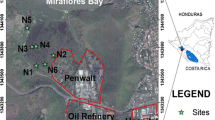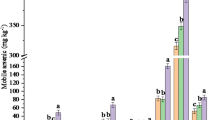Abstract
Three sequential extraction procedures (SEPs), modified Tessier, modified BCR, and CIEMAT, were compared for mercury fractionation in polluted soils. With satisfactory total mercury recovery, the modified Tessier and modified BCR SEPs were comparable with each other in terms of extraction efficiency in equivalent mercury fractions, whereas both SEPs were not as efficient as the CIEMAT SEP. However, the CIEMAT SEP might underestimate the oxidizable mercury fractions due to the humic and fulvic complexes instead of the organic matter of the other two SEPs. For mercury bioavailability identification, based on Pearson correlation analysis, all fractions in each SEP were significantly correlated with mercury uptake in Ipomoea aquatica, causing difficulty in comparison. Partial correlation analysis indicated that the mobile mercury fractions extracted by the first step in all three SEPs had a positive correlation with mercury uptake by plant, while mercury bound to organic matter extracted by both modified Tessier and modified BCR SEPs presented negative correlation with mercury uptake by plant which was in contrast to CIEMAT SEP. Meanwhile, clearly positive correlations between mercury fractions extracted by the former three steps of CIEMAT SEP and mercury uptake in Ipomoea aquatica were observed, demonstrating that CIEMAT SEP provided more accurate results related to Hg bioavailability than did the other two SEPs.


Similar content being viewed by others
References
Alborés AF, Cid BP, Gómez EF, López EF (2000) Comparison between sequential extraction procedures and single extractions for metal partitioning in sewage sludge samples. Analyst 125:1353–1357
Bacon JR, Davidson CM (2008) Is there a future for sequential chemical extraction? Analyst 133:25–46
Beckett PH (1989) The use of extractants in studies on trace metals in soils, sewage sludges, and sludge-treated soils, advances in soil science. Springer, pp. 143–176
Biester H, Scholz C (1996) Determination of mercury binding forms in contaminated soils: mercury pyrolysis versus sequential extractions. Environ Sci Technol 31:233–239
Biester H, Gosar M, Müller G (1999) Mercury speciation in tailings of the Idrija mercury mine. J Geochem Explor 65:195–204
Bloom NS, Preus E, Katon J, Hiltner M (2003) Selective extractions to assess the biogeochemically relevant fractionation of inorganic mercury in sediments and soils. Anal Chim Acta 479:233–248
Chakraborty P, Babu PR, Vudamala K, Ramteke D, Chennuri K (2014) Mercury speciation in coastal sediments from the central east coast of India by modified BCR method. Mar Pollut Bull 81:282–288
Chanu LB, Gupta A (2016) Phytoremediation of lead using Ipomoea aquatica Forsk. In hydroponic solution. Chemosphere 156:407–411
Cui L, Feng X, Lin CJ, Wang X, Meng B, Wang X, Wang H (2014) Accumulation and translocation of 198Hg in four crop species. Environ Toxicol Chem 33:334–340
Davidson CM, Thomas RP, McVey SE, Perala R, Littlejohn D, Ure AM (1994) Evaluation of a sequential extraction procedure for the speciation of heavy metals in sediments. Anal Chim Acta 291:277–286
Davidson CM, Duncan AL, Littlejohn D, Ure AM, Garden LM (1998) A critical evaluation of the three-stage BCR sequential extraction procedure to assess the potential mobility and toxicity of heavy metals in industrially-contaminated land. Anal Chim Acta 363:45–55
Dong H, Lin Z, Wan X, Feng L (2017) Risk assessment for the mercury polluted site near a pesticide plant in Changsha, Hunan, China. Chemosphere 169:333–341
EPA U (2007): Mercury in sediment and tissue samples by atomic fluorescence spectrometry. United States Environmental Protection Agency pp 1–19
Feng X, Li P, Qiu G, Wang S, Li G, Shang L, Meng B, Jiang H, Bai W, Li Z (2007) Human exposure to methylmercury through rice intake in mercury mining areas, Guizhou Province. China Environ Sci Technol 42:326–332
Fernández-Martínez R, Rucandio MI (2003) Study of extraction conditions for the quantitative determination of Hg bound to sulfide in soils from Almaden (Spain). Anal Bioanal Chem 375:1089–1096
Fernández-Martínez R, Rucandio MI (2005) Study of the suitability of HNO3 and HCl as extracting agents of mercury species in soils from cinnabar mines. Anal Bioanal Chem 381:1499–1506
Fernández-Martínez R, Rucandio I (2013) Assessment of a sequential extraction method to evaluate mercury mobility and geochemistry in solid environmental samples. Ecotoxicol Environ Saf 97:196–203
Fernández-Martínez R, Loredo J, Ordóñez A, Rucandio I (2014) Mercury availability by operationally defined fractionation in granulometric distributions of soils and mine wastes from an abandoned cinnabar mine. Environ Sci: Processes & Impacts 16:1069–1075
Fernández-Martínez R, Rucandio I (2014) Total mercury, organic mercury and mercury fractionation in soil profiles from the Almadén mercury mine area. Environ Sci: Proc Impacts 16:333–340
Filgueiras AV, Lavilla I, Bendicho C (2002) Chemical sequential extraction for metal partitioning in environmental solid samples. J Environ Monit 4:823–857
Gleyzes C, Tellier S, Astruc M (2002) Fractionation studies of trace elements in contaminated soils and sediments: a review of sequential extraction procedures. TrAC Trends Anal Chem 21:451–467
Halim M, Conte P, Piccolo A (2003) Potential availability of heavy metals to phytoextraction from contaminated soils induced by exogenous humic substances. Chemosphere 52:265–275
Hu J, Chan PT, Wu F, Wu S, Zhang J, Lin X, Wong MH (2013) Arbuscular mycorrhizal fungi induce differential Cd and P acquisition by Alfred stonecrop (Sedum alfredii Hance) and upland kangkong (Ipomoea aquatica Forsk.) in an intercropping system. Appl Soil Ecol 63:29–35
Issaro N, Abi-Ghanem C, Bermond A (2009) Fractionation studies of mercury in soils and sediments: a review of the chemical reagents used for mercury extraction. Anal Chim Acta 631:1–12
Kelling KA, Peterson AE, Walsh LM, JAR KDR et al (1977) A field study of the agricultural use of sewage sludge: I. Effect on crop yield and uptake of N and P. J Environ Qual 6:339–345
Kim CS, Bloom NS, Rytuba JJ, Brown GE (2003) Mercury speciation by X-ray absorption fine structure spectroscopy and sequential chemical extractions: a comparison of speciation methods. Environ Sci Technol 37:5102–5108
Leopold K, Foulkes M, Worsfold P (2010) Methods for the determination and speciation of mercury in natural waters—a review. Anal Chim Acta 663:127–138
Li J, Lu Y, Shim H, Deng X, Lian J, Jia Z, Li J (2010) Use of the BCR sequential extraction procedure for the study of metal availability to plants. J Environ Monit 12:466–471
Mäkelä M, Pöykiö R, Watkins G, Nurmesniemi H, Dahl O (2011) Application of a modified BCR approach to investigate the mobility and availability of trace elements (As, Ba, Cd, Co, Cr, Cu, Mo, Ni, Pb, Zn, and Hg) from a solid residue matrix designed for soil amendment. World Academy of Science. Eng Technol 79:502–507
Manara A (2012): Plant responses to heavy metal toxicity, plants and heavy metals. Springer, pp. 27–53
Mihaljevič M, Poňavič M, Ettler V, Šebek O (2003) A comparison of sequential extraction techniques for determining arsenic fractionation in synthetic mineral mixtures. Anal Bioanal Chem 377:723–729
Millán R, Gamarra R, Schmid T, Sierra M, Quejido A, Sánchez D, Cardona A, Fernández M, Vera R (2006) Mercury content in vegetation and soils of the Almadén mining area (Spain). Sci Total Environ 368:79–87
Mizanur Rahman G, Skip’Kingston H, Kern JC, Hartwell SW, Anderson RF, Yang SY (2005) Inter-laboratory validation of EPA method 3200 for mercury speciation analysis using prepared soil reference materials. Appl Organomet Chem 19:301–307
Mohamed A, Rashed M, Mofty A (2003) Assessment of essential and toxic elements in some kinds of vegetables. Ecotoxicol Environ Saf 55:251–260
Nasrabadi M, Omid M, Mazdeh AM (2017) Cadmium adsorption characteristics for Karaj riverbed sands. J Mater Environ Sci 8:1729–1736
Nelson D, Sommers LE (1982): Total carbon, organic carbon, and organic matter. Methods of soil analysis. Part 2. Chemical and Microbiological Properties, 539–579
Ordóñez A, Álvarez R, Loredo J (2013) Asturian mercury mining district (Spain) and the environment: a review. Environ Sci Pollut Res 20:7490–7508
Paz-Ferreiro J, Lu H, Fu S, Méndez A, Gascó G (2014) Use of phytoremediation and biochar to remediate heavy metal polluted soils: a review. Solid Earth 5:65–75
Pickering W (1986) Metal ion speciation—soils and sediments (a review). Ore Geol Rev 1:83–146
Quevauviller P, Rauret G, López-Sánchez J-F, Rubio R, Ure A, Muntau H (1997) Certification of trace metal extractable contents in a sediment reference material (CRM 601) following a three-step sequential extraction procedure. Sci Total Environ 205:223–234
Ravichandran M, Aiken GR, Ryan JN, Reddy MM (1999) Inhibition of precipitation and aggregation of metacinnabar (mercuric sulfide) by dissolved organic matter isolated from the Florida Everglades. Environ Sci Technol 33:1418–1423
Reis AT, Rodrigues SM, Davidson CM, Pereira E, Duarte AC (2010) Extractability and mobility of mercury from agricultural soils surrounding industrial and mining contaminated areas. Chemosphere 81:1369–1377
Reis AT, Coelho JP, Rucandio I, Davidson CM, Duarte AC, Pereira E (2015) Thermo-desorption: a valid tool for mercury speciation in soils and sediments? Geoderma 237:98–104
Reis AT, Davidson CM, Vale C, Pereira E (2016) Overview and challenges of mercury fractionation and speciation in soils. TrAC Trends Anal Chem 82:109–117
Remon E, Bouchardon JL, Cornier B, Guy B, Leclerc JC, Faure O (2005) Soil characteristics, heavy metal availability and vegetation recovery at a former metallurgical landfill: implications in risk assessment and site restoration. Environ Pollut 137:316–323
Rodushkin I, Ruth T, Aring H s (1999) Comparison of two digestion methods for elemental determinations in plant material by ICP techniques. Anal Chim Acta 378:191–200
Sahuquillo A, Rauret G, Bianchi M, Rehnert A, Muntau H (2003) Mercury determination in solid phases from application of the modified BCR-sequential extraction procedure: a valuable tool for assessing its mobility in sediments. Anal Bioanal Chem 375:578–583
Sánchez D, Quejido A, Fernández M, Hernández C, Schmid T, Millán R, González M, Aldea M, Martín R, Morante R (2005) Mercury and trace element fractionation in Almaden soils by application of different sequential extraction procedures. Anal Bioanal Chem 381:1507–1513
Silveira M, Alleoni L, O’connor G, Chang A (2006) Heavy metal sequential extraction methods—a modification for tropical soils. Chemosphere 64:1929–1938
Sundaray SK, Nayak BB, Lin S, Bhatta D (2011) Geochemical speciation and risk assessment of heavy metals in the river estuarine sediments—a case study: Mahanadi basin, India. J Hazard Mater 186:1837–1846
Sungur A, Soylak M, Ozcan H (2014) Investigation of heavy metal mobility and availability by the BCR sequential extraction procedure: relationship between soil properties and heavy metals availability. Chem Speciat Bioavailab 26:219–230
Tessier A, Campbell PG, Bisson M (1979) Sequential extraction procedure for the speciation of particulate trace metals. Anal Chem 51:844–851
Wallschläger D, Desai MV, Spengler M, Wilken R-D (1998) Mercury speciation in floodplain soils and sediments along a contaminated river transect. J Environ Qual 27:1034–1044
Wan X, Dong H, Feng L, Lin Z, Luo Q (2017) Comparison of three sequential extraction procedures for arsenic fractionation in highly polluted sites. Chemosphere 178:402–410
Wang S, Zhao Y, Guo J, Zhou L (2016) Effects of Cd, Cu and Zn on Ricinus communis L. growth in single element or co-contaminated soils: pot experiments. Ecol Eng 90:347–351
Xiao Q, Wong MH, Huang L, Ye Z (2015) Effects of cultivars and water management on cadmium accumulation in water spinach (Ipomoea aquatica Forsk.). Plant Soil 391:33–49
Yu S, He ZL, Huang CY, Chen GC, Calvert DV (2004) Copper fractionation and extractability in two contaminated variable charge soils. Geoderma 123:163–175
Zheng M, Feng L, He J, Chen M, Zhang J, Zhang M, Wang J (2015) Delayed geochemical hazard: a tool for risk assessment of heavy metal polluted sites and case study. J Hazard Mater 287:197–206
Zhong H, Wang W-X (2008) Effects of sediment composition on inorganic mercury partitioning, speciation and bioavailability in oxic surficial sediments. Environ Pollut 151:222–230
Funding
The authors received financial support for this work from the Ministry of Land and Resources of P. R. China (Grant No. 201411089).
Author information
Authors and Affiliations
Corresponding author
Additional information
Responsible editor: Severine Le Faucheur
Publisher’s note
Springer Nature remains neutral with regard to jurisdictional claims in published maps and institutional affiliations.
Electronic supplementary material
ESM 1
(DOCX 16 kb)
Rights and permissions
About this article
Cite this article
Dong, H., Feng, L., Qin, Y. et al. Comparison of different sequential extraction procedures for mercury fractionation in polluted soils. Environ Sci Pollut Res 26, 9955–9965 (2019). https://doi.org/10.1007/s11356-019-04433-6
Received:
Accepted:
Published:
Issue Date:
DOI: https://doi.org/10.1007/s11356-019-04433-6




